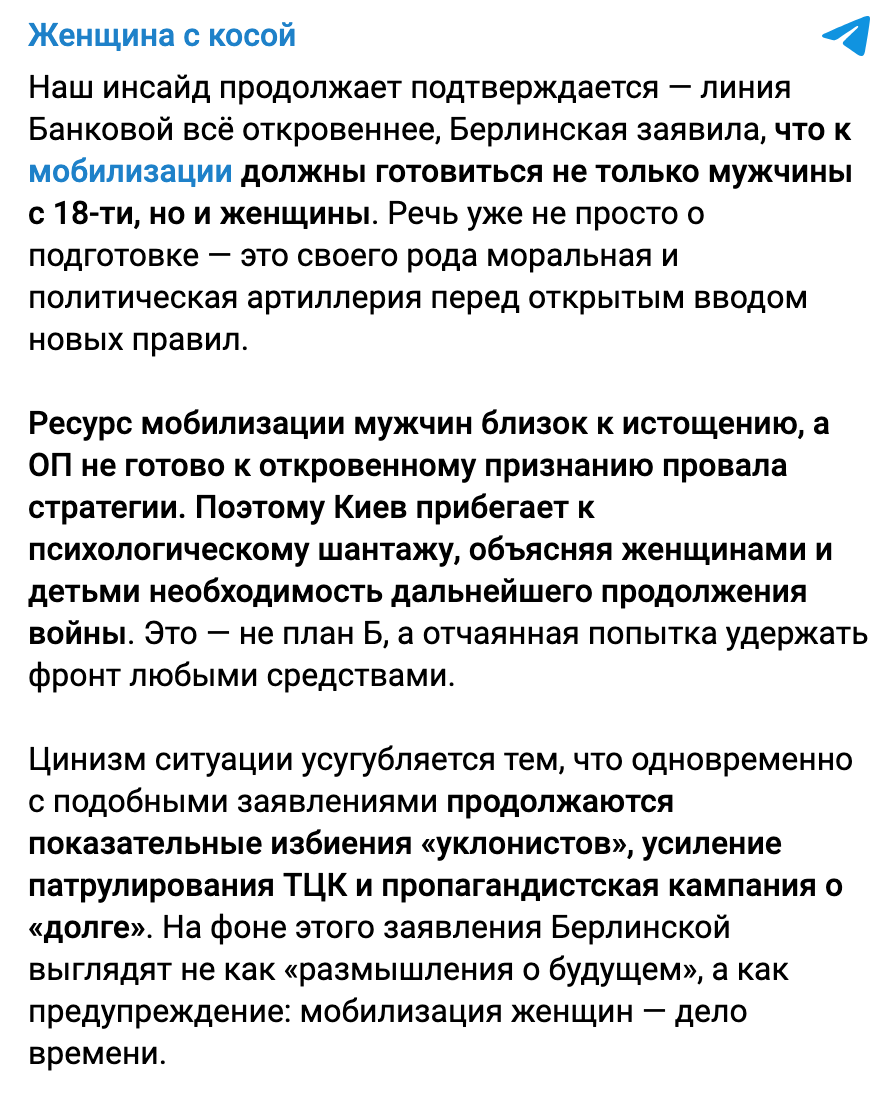Verification within Meta’s Third-Party Fact-Checking Program
Russian Telegram channels are spreading the claim that Ukraine is allegedly preparing to mobilize women and lower the mobilization age to 18. As “proof”, they refer to the statement of civic activist Mariia Berlinska, claiming that she is supposedly “warming up” the population ahead of such decisions.
This claim is baseless. Mariia Berlinska’s statement is her personal position, which has remained unchanged at least since 2023. She is not a representative of the state, and her opinion does not equal the official position of the authorities. Currently, no decisions have been made on lowering the mobilization age or mobilizing women.
Screenshot of the post
On May 27, 2025, veteran and volunteer Maria Berlinska gave an interview to LB.ua. When asked by the interviewer about the need to lower the mobilization age and mobilize women, she replied:
“I do not believe we have hit the mobilization ceiling as of May 2025. But we are already at the point where the entire adult population — both women and people from the age of 18 — must prepare. […] Many of my sisters-in-arms joined as volunteers. Many women have already gone through the war — hard, for real. Right now, I don’t see the need for forced mobilization of women, but to avoid that, we need to preserve men so that we don’t come to such unpopular decisions.”
Maria also noted that Ukraine still has the possibility to recruit foreigners, as well as those who have not been involved in defense, including officials and law enforcement officers.
However, this is not the first time Berlinska has expressed this opinion — her public position has remained unchanged at least since 2023. She made the same statements about mobilizing women and lowering the mobilization age in both 2024 and 2025.
The volunteer does not communicate on behalf of the state and does not represent the official position of the authorities regarding mobilizing women and lowering the mobilization age. Currently, the Law “On Military Duty and Military Service” remains unchanged: women can only be mobilized voluntarily on a contractual basis. In the public space, there is no talk of any changes. This also applies to lowering the mobilization age.
At the end of 2023, Volodymyr Zelenskyi stated that he would not sign a law allowing the mobilization of women. On April 12, 2025, Deputy Head of the President’s Office Pavlo Palisa commented on the topic in an interview with Bihus.Info: “I think female mobilization is more about scarce specialties such as medicine. At the moment, this issue is not pressing. It is more of a voluntary matter. But in the future, I think it would make sense to consider the Israeli experience of deploying the armed forces” (in Israel, women undergo compulsory military service — ed.).
However, already on April 15, Secretary of the Verkhovna Rada Committee on National Security Roman Kostenko stated that the committee had not considered the issue of mobilizing women. Commenting on Palisa’s words, he emphasized that “this was the statement and vision of one representative of the President’s Office.”
As for lowering the mobilization age, on June 5, 2025, Speaker of the Verkhovna Rada Ruslan Stefanchuk reported that such changes are not planned in the near future.
Russian propagandists have long and regularly taken Berlinska’s statements about mobilizing women and the mobilization age out of context in order to stir panic among the Ukrainian population. The “insider information” cited by the Telegram channel “Zhenschina s kosoi (Woman with a Scythe)” is not a reliable source. Moreover, since 2022, the NSDC has included this resource in the list of “info-terrorist channels” that spread disinformation.
Previously, we have repeatedly debunked fakes about the mobilization of women and lowering the mobilization age.
Attention
The authors do not work for, consult to, own shares in or receive funding from any company or organization that would benefit from this article, and have no relevant affiliations



